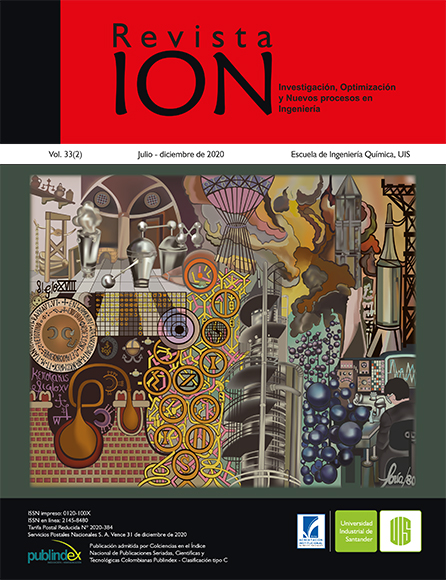Design of an electrolytic cell for the application of metal coatings
Published 2020-11-12
Keywords
- Electrolytic Cell,
- Electrocoating,
- Design
How to Cite

This work is licensed under a Creative Commons Attribution 4.0 International License.
Abstract
In this research, the design of a new laboratory cell configuration for the application of metallic electrolytic coatings such as: electroplating, chrome plating, copper plating, anodizing, among others. For the design of this cell, variables with specific ranges such as: a volume between 100 and 500 ml of the electrolytic solution, a cathode size between 0.1 and 0.33 dm2 of the exposed area, anodes between 1 and 2 times the cathode area, were defined. A current source with a maximum density of 9 A/dm2. Was adapted to the cell, in addition, it presents a variation in the distance between anode and cathode by means of sliding guides to optimize the investigation processes. The container where the electrolytic solution is deposited, in the cell is made of Pyrex type refractory and its cover was made of ABS (Acrylonitrile Butadiene Styrene) to avoid deterioration due to the effects of corrosion due to electrolytic solutions. For the positioning of the electrodes, it was designed an electrode holder (anode holder and cathode holder) with interchangeable characteristics for multiple anodes and cathodes as required by experimentation. To validate the proper behavior of the cell, a Zinc coating on 1020 steel was deposited, obtaining a homogeneous and continuous electrozinc coating. The electrocoating cell allows to experiment with different types of substrates such as steels, aluminum or titanium alloys, among others, in final industrial applications or in pre-processes.
Downloads
References
[2] Muralidhara HB, Balasubramanyam J, Naik YA, Kumar KY, Hanumanthappa H, Veena MS. Electrodeposition of Nanocrystalline Zinc on Steel Substrate from Acid Sulphate Bath and its Corrosion Study. J. Chem. Pharm. Res. 2011;3:433-449.
[3] Molera Solá P. Recubrimiento de los Metales. España: Productica Marcombo S.A; 1990.
[4] Jose A. Ortega M. Corrosión Industrial. España:Productica Marcombo S.A; 1989.
[5] Zhang Z, Leng WH, Cai QY, Cao FH, Zhang JQ. Study of the zinc electroplating process using electrochemical noise technique. J. Electroanal. Chem. 2005;578(2):357-367.
[6] Vasilakopoulos D, Bouroushian M, Spyrellis N. Texture and morphology of pulse plated zinc electrodeposits. J Mater Sci. 2006;41:2869-2875.
[7] Praveen BM, Venkatesha TV. Generation and Corrosion Behavior of Zn-Nano Sized Carbon Black Composite Coating. Int. J. Electrochem. Sci. 2009;4:258-266.
[8] American Galvanizers Association. Zinc Coatings. Colorado, United States; 2011.
[9] Federal Aviation Administration. Aircraft Cleaning y Corrosion Control - Corrosion control. United States: Federal Aviation Administration; 2018.
[10] ASTM E797 / E797M-15. Standard Practice for Measuring Thickness by Manual Ultrasonic Pulse-Echo Contact Method. United States: ASTM International; 2015.
[11] ASTM F1375-92. Método de prueba estándar para la dispersión de energía de rayos X Espectrómetro (EDX) Análisis de la Situación de la superficie metálica para la Distribución de Gas componentes del sistema. United States: ASTM International; 2012.
[12] ASTM B117-11. Standard Practice for Operating Salt Spray (Fog) Apparatus. United States: ASTM International; 2011.
[13] ASTM D3359-09e2. Standard Test Methods for Measuring Adhesion by Tape Test. United States: ASTM International; 2009.
[14] ASTM G5-94. Standard Reference Test Method for Making Potentiostatic and Potentiodynamic Anodic Polarization Measurements. United States: ASTM International; 2011.
[15] ASTM G59 – 97. Standard Test Method for Conducting Potentiodynamic Polarization Resistance Measurements. United States: ASTM International; 2014.
[16] ASTM G102 – 89. Standard Practice for Calculation of Corrosion Rates and Related Information from Electrochemical Measurements. United States: ASTM International; 2015.
[17] ASTM G1 – 03. Standard Practice for Preparing, Cleaning, and Evaluating Corrosion Test Specimens. United States: ASTM International; 2011.

